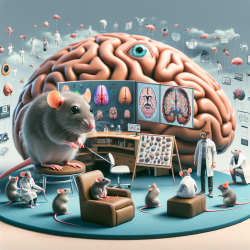Unveiling the Impact of Maternal Immune Activation on Neurodevelopment: Implications for Child Therapy
As a speech-language pathologist, understanding the intricacies of neurodevelopmental disorders is crucial for creating effective therapy strategies. Recent research published in the International Journal of Molecular Sciences titled Maternal Immune Activation Induces Neuroinflammation and Cortical Synaptic Deficits in the Adolescent Rat Offspring provides groundbreaking insights that could reshape our approach to child therapy.
The Study: Maternal Immune Activation and Its Consequences
The study explores the effects of maternal immune activation (MIA) on the neurodevelopment of adolescent rat offspring. MIA, often induced by infections during pregnancy, has been identified as a significant risk factor for neurodevelopmental disorders, including autism spectrum disorders (ASD). This research specifically examines how MIA affects neuroinflammation and synaptic morphology in the cerebral cortex of adolescent rats.
Key findings from the study include:
- Elevated blood cytokine levels and increased pro-inflammatory cytokines expression in MIA offspring.
- Pathological changes in synaptic ultrastructure, including presynaptic protein deficits and down-regulation of postsynaptic scaffolding proteins.
- Behavioral alterations in MIA offspring, indicative of autism-like behaviors.
Implications for Child Therapy
These findings have profound implications for child therapy, particularly in understanding and addressing the underlying causes of neurodevelopmental disorders. Here are some potential applications:
- Early Intervention: Identifying children at risk due to maternal immune activation could allow for earlier interventions, potentially mitigating the impact of neurodevelopmental disorders.
- Targeted Therapies: Understanding the specific synaptic deficits caused by MIA can lead to the development of targeted therapies that address these neurological changes.
- Holistic Approaches: Incorporating knowledge of neuroinflammation into therapy practices could enhance the effectiveness of interventions by addressing both behavioral and biological aspects of disorders.
Encouraging Further Research
While this study provides valuable insights, it also highlights the need for further research to fully understand the mechanisms linking MIA to neurodevelopmental disorders. Practitioners are encouraged to stay informed about ongoing research and consider participating in studies that explore the intersection of neuroinflammation, synaptic deficits, and child therapy outcomes.
To read the original research paper, please follow this link: Maternal Immune Activation Induces Neuroinflammation and Cortical Synaptic Deficits in the Adolescent Rat Offspring.
Conclusion
The intersection of research and practice is where real change happens. By integrating the findings from this study into therapy practices, we can improve outcomes for children with neurodevelopmental disorders. Let's continue to advocate for data-driven approaches that enhance the lives of the children we serve.










